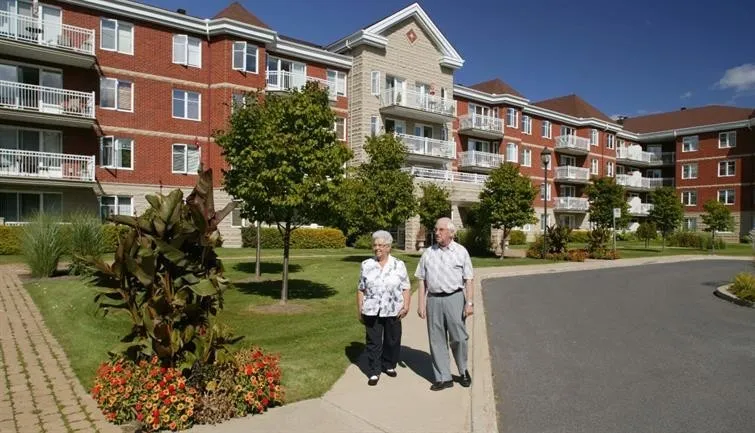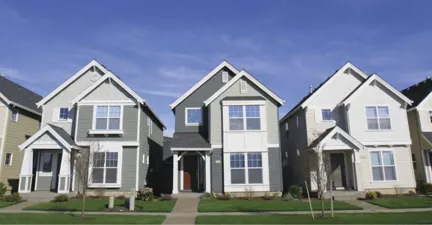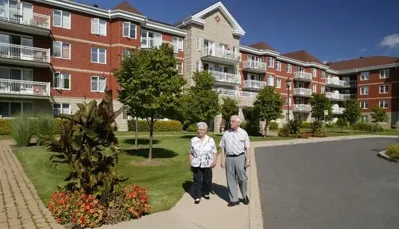Senior Apartments in 2025
Senior apartments are enticing options, as the living cost is lower, the benefits are ample, and the maintenance is minimal. Plus, it has all the perks of independent living without all the hassle.
Read on to learn more about the types of senior apartments, their costs, and how to pay for them (whether you rent or buy). Many seniors have limited income, so we’ll dive into affordable housing for seniors and how to apply for federal and state assistance.

What Is a Senior Apartment?
Packed with age-friendly accommodations and amenities, a senior apartment caters to the lifestyles of older adults. As we age, our needs change, so these age-restricted apartments (typically 55+ or 62+ or older) have us covered. Senior apartments are built with the needs of older adults in mind. For example, the quarters may offer ground-level accommodations such as an elevator, wheelchair-accessible units, and safety features.
Senior apartments vary in size and setup with many different types of 55+ communities ranging from golf and resort communities to singles communities. Studio apartments offer a compact yet open floor plan. There’s only one room (other than the bathroom), but it contains everything you need for a complete living experience.
Other lodgings are suite-style, meaning each older adult has a bedroom while sharing a common living space, kitchen, and bathroom with other residents. Or, if you need more space to stretch out, choose a multiroom one• or two-bedroom apartment.
Many communities include common areas to chat over coffee, relax during movie night, and enjoy a meal in the dining lounge. They also provide social activities and ways to pick up a new hobby. They may even have more luxury amenities like a pool or clubhouse, giving you more ways to connect with your neighbors.
Who Lives in Senior Apartments?
Senior apartments have a wide range of residents! Here’s a snapshot of adults who call a senior apartment “home sweet home,” including those who:
• Have sold their home and downsized to simplify their lifestyle.• Want the freedom to travel without the worry about property left behind.• Want a place with minimal responsibilities and upkeep.• Are divorced, widowed, or never married.• Have relocated to be closer to family and friends.• Want a lower-cost living solution.• Want to be around their peers.• Are looking for a sense of community and safety.
Types of Senior Apartments
There are generally three pricing categories of senior living apartments — affordable, market rate, and luxury. However, you may not find all three in every market.
Affordable Senior Living Apartments
Income-restricted older adults may qualify for affordable senior living apartments through federal, state, and local housing programs. Rent goes below the market rate, with eligibility based on income, family size, the area’s median income (AMI), and other factors. Amenities in low-income senior apartments tend to be limited.
Market Rate Senior Living Apartments
Unlike affordable living apartments, market-rate senior apartments don’t have income limits. They often include amenities like housekeeping, transportation, and community dining. Market-rate apartments are competitively priced based on comparable housing in the area. However, carefully choose where you decide to live, as the Harvard Joint Center for Housing Studies (JCHS) reports that rent in professionally managed apartment buildings has skyrocketed in the past few years.
Luxury Senior Living Apartments
At the top of the price line, you’ll find resort-style luxury apartments for seniors. They’re larger, often up to 2,000 square feet, and provide plenty of upscale amenities and community activities for their residents. It’s common for luxury apartments to be gated communities, offering privacy, security, and a feeling of exclusivity. Be prepared to pay a steep price tag. The entrance fee alone can reach six digits.
How Much Does a Senior Apartment Cost?
Just like any other type of housing, senior apartment costs vary greatly. Before you begin apartment hunting, ensure your finances are in order and set a budget. Average senior apartment rental prices across the U.S. vary greatly. For example, Brookdale Senior Living, the biggest assisted living provider in the United States, reports its prices range from $3,535 to $12,560 per month in the Southeast, to $3,395 to $10,435 per month in the Midwest.
Major factors that impact the overall cost include location, amenities, and apartment size. For example, a senior living one-bedroom apartment in rural Ohio will cost significantly less than a comparable senior apartment in New York City. If you’re on a budget, consider following these helpful frugal living tips for seniors.
Buying a Senior Apartment
It’s common to find senior apartments for sale in continuing care retirement communities (CCRCs). Buying into these communities is a long-term investment that enables older adults to transition to different housing and care levels. For example, an individual may initially move into a senior apartment but need assisted living, memory care, or hospice care in the future. CCRCs provide a multifaceted network of senior living options in one community. All your current (and future) health and wellness needs are covered! Before investing in a senior apartment, consider factors like tax implications and resale restrictions.
Renting a Senior Apartment
Most apartment rentals go through an apartment management company or assisted living community. Take time to weigh the pros and cons of renting a senior apartment. A significant benefit is that renting is a short-term commitment. You are free to move if your needs change, and you don’t have to worry about budgeting for property taxes. Plus, renter’s insurance is considerably less than homeowner’s insurance. On the flip side, you don’t own the property. Therefore, you won’t earn any profit. Altering the apartment, such as painting the walls, may be forbidden. Another point worth remembering is that income-based senior apartments include strict government guidelines; not all older adults qualify for income-based housing.
Low-Income Apartments for Seniors
There are more than 17 million economically insecure older adults with incomes below 200 percent of the federal poverty level. With rising inflation and the dramatic increases in living costs, many areas of our country are in an affordable housing crisis. That’s where low-income apartments for older adults come into play.
There are several types of limited-income housing for seniors, including those offered through the U.S. Department of Housing and Urban Development (HUD), Veterans Affairs, local and state subsidies, and nonprofit organizations.
Federal and state agencies determine the income guidelines for low-income apartments. To find out if you qualify and for a list of senior apartment locations, contact your local public housing agency or HUD office.
Once you find a senior apartment, it’s time to apply. Remember, most apartments are occupied, with applicants on a waiting list. However, certain exceptions will help your case, such as being homeless or living in an unsafe environment. Submitting your application to multiple HUD-sponsored apartments may increase the chances of being selected.
Featured Articles
 Affordable Senior Housing OptionsAs the aging population in the U.S. continues to grow, so does the demand for affordable senior living options. Many older adults struggle to afford both housing and care.
Affordable Senior Housing OptionsAs the aging population in the U.S. continues to grow, so does the demand for affordable senior living options. Many older adults struggle to afford both housing and care. How Can Seniors Get Affordable Independent Living Apartments Under 300$ Per MonthFinding affordable senior living apartments can be challenging, especially for seniors on a fixed income. However, opportunities exist where seniors can find independent living communities at a low cost. Learn how to find affordable senior living solutions that work for you.
How Can Seniors Get Affordable Independent Living Apartments Under 300$ Per MonthFinding affordable senior living apartments can be challenging, especially for seniors on a fixed income. However, opportunities exist where seniors can find independent living communities at a low cost. Learn how to find affordable senior living solutions that work for you. How Seniors Can Find Affordable ApartmentsAs the aging population in the United States grows, finding affordable housing has become increasingly important for seniors. Many older adults live on fixed incomes and face rising living costs, making it crucial to identify options that provide both affordability and comfort. Fortunately, there are various resources and strategies available for seniors seeking low-cost apartments.
How Seniors Can Find Affordable ApartmentsAs the aging population in the United States grows, finding affordable housing has become increasingly important for seniors. Many older adults live on fixed incomes and face rising living costs, making it crucial to identify options that provide both affordability and comfort. Fortunately, there are various resources and strategies available for seniors seeking low-cost apartments.